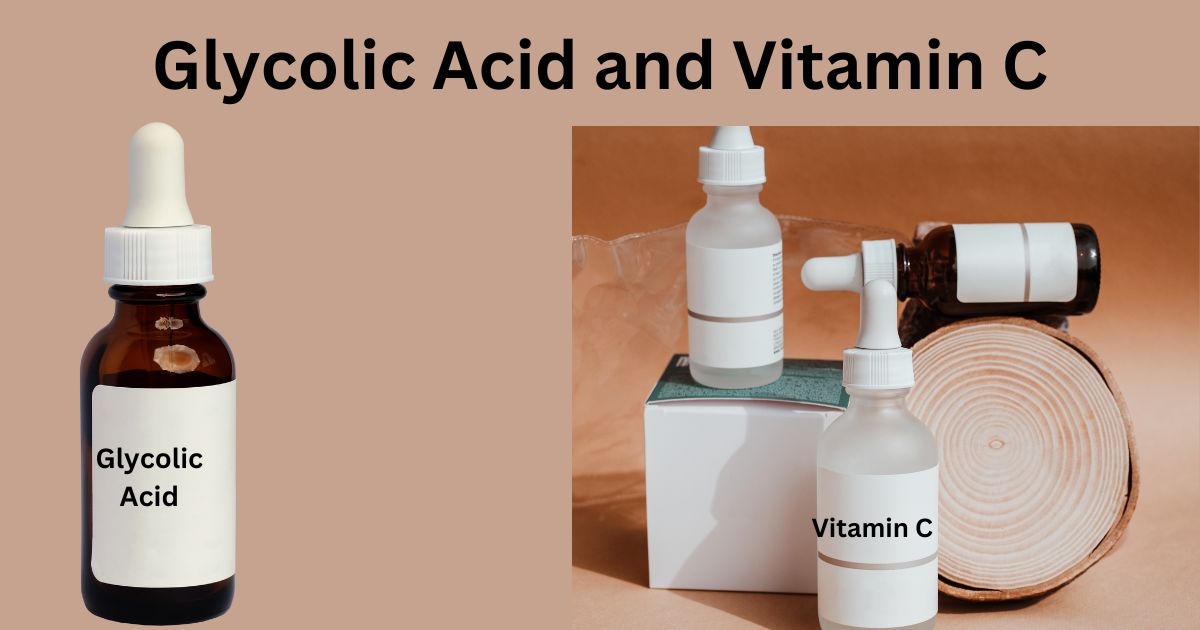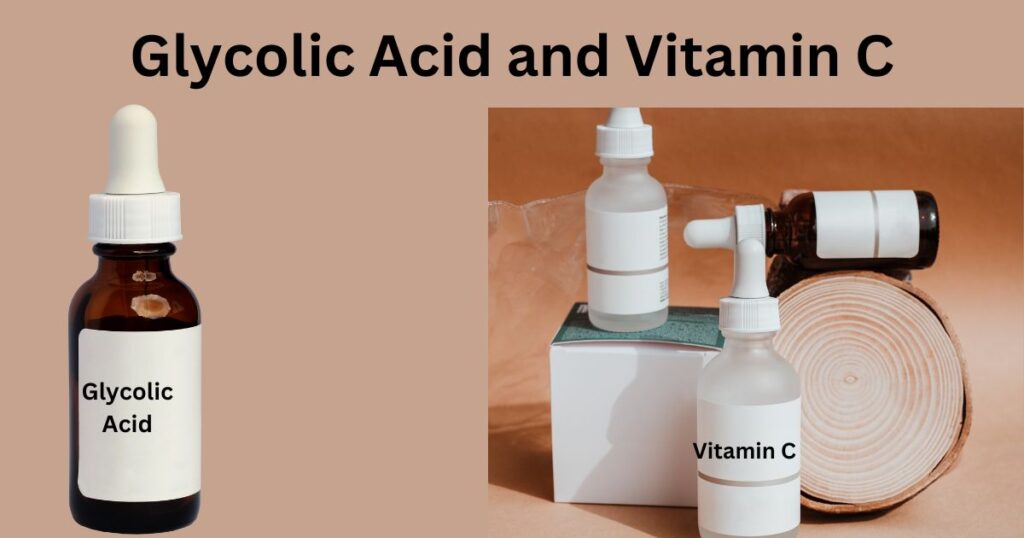The Power Duo: Glycolic Acid and Vitamin C for Radiant Skin
Glycolic acid and vitamin C are two powerful skincare ingredients that have gained significant attention for their remarkable benefits. Glycolic acid, a type of alpha hydroxy acid (AHA), is renowned for its exfoliating properties, helping to remove dead skin cells, unclog pores, and promote cell turnover, resulting in smoother and more radiant skin. On the other hand, vitamin C, a potent antioxidant, plays a crucial role in collagen synthesis, brightening the complexion, and protecting the skin from harmful free radicals.
When combined, glycolic acid and vitamin C create a dynamic duo, offering a comprehensive approach to skincare, targeting various concerns and promoting a youthful and healthy-looking complexion.. In this article, we will explore the individual properties of glycolic acid and vitamin C, their combined effects, and how to incorporate them into your skincare regimen to achieve radiant skin.
 Glycolic Acid: Unveiling the Magic of Exfoliation
Glycolic Acid: Unveiling the Magic of Exfoliation
Glycolic acid, derived from sugarcane, is a type of alpha hydroxy acid (AHA) known for its exfoliating properties. Its small molecular size allows it to penetrate the skin deeply, effectively dissolving dead skin cells and unclogging pores. Let’s dive deeper into the benefits of incorporating glycolic acid into your skincare routine.
1. Exfoliation for a Fresh Start
Glycolic acid acts as a chemical exfoliant, gently dissolving the bonds that hold dead skin cells together. By removing this layer of dull and lifeless skin, it reveals a fresh and vibrant complexion underneath. Regular use of glycolic acid helps to improve skin texture, minimize the appearance of fine lines and wrinkles, and reduce hyperpigmentation.
You may also like..The Ordinary Glycolic Acid 7 Toning Solution Niacinamide and Glycolic Acid:10 effective benefits of the Power Duo for Skin Care Can Niacinamide and Salicylic Acid be used together? 10 Powerful benefits
2. Unclogging Pores and Preventing Acne
Clogged pores are a common culprit behind acne breakouts. Glycolic acid effectively penetrates the skin and helps to remove impurities, excess oil, and debris that can accumulate within the pores. By keeping the pores clear, glycolic acid reduces the likelihood of breakouts and helps to maintain a clearer complexion.
3. Stimulating Collagen Production
Collagen, a protein responsible for maintaining skin’s elasticity and firmness, naturally declines with age. However, glycolic acid helps to stimulate collagen production, promoting a more youthful and plump appearance. By incorporating glycolic acid into your skincare routine, you can help counteract the signs of aging, such as sagging skin and fine lines.
4. Addressing Hyperpigmentation
Uneven skin tone and hyperpigmentation can be a source of frustration for many individuals. Glycolic acid aids in fading dark spots, acne scars, and sun damage by accelerating the skin’s natural exfoliation process. With consistent use, glycolic acid can help achieve a more even and radiant complexion.
Vitamin C: The Antioxidant Powerhouse
Vitamin C, also known as ascorbic acid, is a potent antioxidant that offers a wide range of benefits for the skin. Let’s explore the remarkable properties of this vitamin and its ability to transform your skin.
1. Protection against Environmental Damage
Our skin is constantly exposed to environmental stressors such as pollution, UV radiation, and free radicals. Vitamin C acts as a shield, protecting the skin from these damaging factors. It neutralizes free radicals, which can cause premature aging, and helps to prevent oxidative stress, keeping the skin looking youthful and healthy.
2. Brightening and Even Complexion
Vitamin C is renowned for its brightening properties. It inhibits the production of melanin, the pigment responsible for dark spots and hyperpigmentation, resulting in a more even skin tone. Regular use of vitamin C can help fade discoloration, revealing a radiant and luminous complexion.
3. Collagen Synthesis and Firmness
Similar to glycolic acid, vitamin C plays a crucial role in collagen synthesis. It aids in the production of collagen, promoting skin elasticity and firmness. By maintaining optimal levels of collagen, vitamin C helps to reduce the appearance of wrinkles and fine lines, giving the skin a smoother and more youthful appearance.
4. Healing and Repairing
Vitamin C possesses exceptional healing properties, making it beneficial for various skin concerns. It aids in the repair of damaged skin cells, stimulates the production of new cells, and accelerates the skin’s natural healing process. This makes it an excellent ingredient for addressing acne scars, sun damage, and other forms of skin damage.
The Power Duo: Combining Glycolic Acid and Vitamin C
Individually, glycolic acid and vitamin C offer remarkable benefits to the skin. However, when combined, their effects are amplified, creating a powerhouse duo for radiant and healthy skin. Here’s how these ingredients work together synergistically:
1. Enhanced Exfoliation and Brightening
The exfoliating properties of glycolic acid, coupled with the brightening effects of vitamin C, result in a potent combination for achieving a radiant complexion. Glycolic acid removes dead skin cells and unclogs pores, allowing vitamin C to penetrate deeply and brighten the skin from within.
2. Collagen Boost and Anti-Aging Benefits
By stimulating collagen production, both glycolic acid and vitamin C contribute to reducing the signs of aging. Glycolic acid promotes collagen synthesis, while vitamin C protects existing collagen from degradation. This combination leads to improved skin elasticity, minimized wrinkles, and a more youthful appearance.
3. Fade Dark Spots and Hyperpigmentation
Glycolic acid’s exfoliating properties and vitamin C’s brightening effects make them an effective duo for addressing hyperpigmentation. Glycolic acid accelerates the exfoliation of darkened skin cells, while vitamin C inhibits melanin production, leading to a more even skin tone and diminished dark spots.
4. Protection against Environmental Damage
Both glycolic acid and vitamin C offer protection against environmental damage. Glycolic acid removes impurities and pollutants from the skin, while vitamin C neutralizes free radicals and prevents oxidative stress. Together, they create a barrier against harmful elements, ensuring your skin stays healthy and youthful.
How to Incorporate Glycolic Acid and Vitamin C into Your Skincare Routine
Now that we understand the benefits of glycolic acid and vitamin C, let’s discuss how to introduce these ingredients into your skincare regimen effectively.
- Cleanser: Start your routine with a glycolic acid cleanser to gently exfoliate and remove impurities. Massage the cleanser onto damp skin, then rinse thoroughly.
- Toner: Follow up with a vitamin C toner to brighten the complexion and prepare the skin for subsequent products. Apply the toner to a cotton pad and gently swipe it over your face and neck.
- Serum: Incorporate a glycolic acid serum into your routine a few times a week. Apply a small amount to your fingertips and gently pat it onto the skin.
- Moisturizer: Choose a moisturizer that contains both glycolic acid and vitamin C for added hydration and benefits. Massage the moisturizer onto clean skin until fully absorbed.
- Sunscreen: As both glycolic acid and vitamin C can increase skin sensitivity to the sun, it’s crucial to apply a broad-spectrum sunscreen with SPF 30 or higher as the final step in your skincare routine.
Conclusion
Incorporating glycolic acid and vitamin C into your skincare routine can yield remarkable results, transforming your skin into a radiant and healthy canvas. These ingredients work synergistically to exfoliate, brighten, and protect the skin, while also combating the signs of aging. By following the recommended steps and gradually introducing these ingredients, you can unlock the power of glycolic acid and vitamin C for a complexion that truly glows.
Disclaimer: The information provided in this article is for educational purposes only and should not be considered as professional medical or skincare advice. Always consult with a qualified dermatologist or healthcare provider before incorporating any new skincare ingredients or products into your routine. It is important to note that skincare products containing glycolic acid and vitamin C may not be suitable for everyone. Individual reactions and sensitivities can vary, so it is advisable to perform a patch test and consult with a dermatologist before incorporating these ingredients into your skincare routine.
FAQs
Can glycolic acid and vitamin C be used together?
Yes, glycolic acid and vitamin C can be used together. They complement each other and provide enhanced benefits for the skin.
Can glycolic acid and vitamin C cause skin irritation?
While glycolic acid and vitamin C are generally well-tolerated, they can cause skin irritation, especially if used in high concentrations or if you have sensitive skin. It's important to start with lower concentrations and gradually increase as your skin adjusts.
Can I use glycolic acid and vitamin C during the day?
Yes, you can use glycolic acid and vitamin C during the day. However, it's crucial to follow up with a broad-spectrum sunscreen as these ingredients can increase sun sensitivity.
How long does it take to see results with glycolic acid and vitamin C?
Results vary from person to person, but with consistent use, you can expect to see improvements in skin texture, brightness, and overall complexion within a few weeks to a couple of months.
an I use glycolic acid and vitamin C if I have sensitive skin?
If you have sensitive skin, it's advisable to start with lower concentrations and perform a patch test before incorporating these ingredients into your routine. If any irritation occurs, discontinue use and consult with a dermatologist.
Can glycolic acid and vitamin C be used on all skin types?
Glycolic acid and vitamin C can be used on most skin types. However, if you have specific skin concerns or conditions, it's best to consult with a dermatologist to determine the most suitable products for your skin.


 Glycolic Acid: Unveiling the Magic of Exfoliation
Glycolic Acid: Unveiling the Magic of Exfoliation

